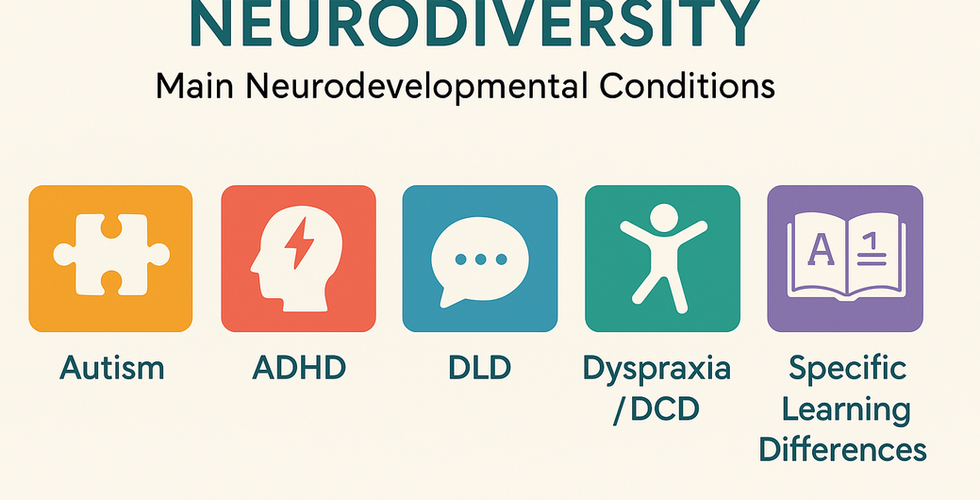Understanding Neurodiversity and How to Support Your Child's Growth
- taniaslt
- Nov 10
- 4 min read
If you observe that your child is developing differently from other children, it can be overwhelming to decide what steps to take. Whether your child has just been diagnosed with a neurodiverse condition or you’re beginning to worry about their communication or development, it's beneficial to understand the situation and know where to seek support.
🌱 Each Child Grows Uniquely
Children develop and learn at their own pace. Some may begin walking, talking, or socialising sooner, while others may take longer. Such differences are completely normal. However, if you have concerns about your child’s development—such as delays in communication, social interaction, or gaining independence—it’s perfectly acceptable to seek advice.
You can consult with your health visitor, GP, nursery SENCO, local SEND services, or a Speech and Language Therapist (SALT) for example. These experts can assist in determining whether your child’s development falls within the typical range or if further evaluation might be beneficial.
🧩 What Does “Neurodiversity” Mean?
Neurodiversity refers to the natural variation in how individuals' brains develop and process information. Instead of viewing these differences as deficits, the neurodiversity perspective recognises that everyone thinks, learns, and communicates uniquely, and these differences offer distinct strengths alongside challenges.
Some of the primary neurodevelopmental conditions associated with neurodiversity include:
Autism - differences in social communication, sensory processing, and flexible thinking.
ADHD (Attention Deficit Hyperactivity Disorder) – affects attention, impulse control, and executive functioning (organization and planning).
Developmental Language Disorder (DLD) – can affect an individual's ability to find the right words, form sentences, understand instructions, and participate in conversations. It can also impact reading and writing skills.
Developmental Coordination Disorder (Dyspraxia / DCD) – affects motor planning, coordination, and movement.
Specific Learning Differences such as dyslexia, dyscalculia, and dysgraphia.
It’s also common for individuals to experience overlap between these areas — for example, ADHD and DCD, or autism and DLD. Professionals therefore adopt a holistic view of a child’s profile, focusing on both strengths and needs.
🩺 Other Developmental and Communication Differences
There are also other conditions that can affect a child’s development or communication but are not classed as neurodiverse conditions. These may occur alongside neurodivergent profiles or independently. Examples include:
Speech Sound Disorders – difficulties producing or sequencing speech sounds clearly.
Hearing Loss – which may affect how speech and language develop.
Cerebral Palsy – a physical disability caused by early brain injury, affecting movement and posture.
While these are not neurodivergent conditions, children with these profiles still benefit from early, tailored intervention and inclusive communication support.
🔍 Early Signs to Look Out For
Some children show early signs of developmental differences in infancy, while others become more noticeable once they reach nursery or school age. You might notice that your child:
Communicates less or later than peers.
Has difficulty playing or interacting with others.
Struggles with attention or following instructions.
Finds certain sounds, textures or changes in routine difficult.
Moves or plays in ways that seem different to others.
If these differences persist or impact your child’s daily life, early identification is key. Getting advice early doesn’t necessarily mean a diagnosis straight away, it simply ensures your child receives the right support at the right time.
🤝 What Happens Next
When concerns are identified, professionals collaborate using a graduated approach (Assess, Plan, Do, Review). This involves:
Assess – Collect information through observation, discussion, and professional insights.
Plan – Agree on strategies or interventions to implement (e.g., small group support, visuals, communication aids).
Do – Consistently apply the plan across both home and setting.
Review – Assess progress and determine if additional input or referral is necessary.
If concerns persist, your child might be referred for a multi-disciplinary developmental assessment through a Child Development Centre (CDC) or similar service. Here, professionals such as Paediatricians, Speech and Language Therapists, Occupational Therapists, and Psychologists work together to fully understand your child’s developmental profile.
🗣️ Supporting Communication at Home
There’s a great deal you can do to support your child’s communication and confidence at home:
Say your child’s name before speaking to gain their attention.
Use simple, clear language and repeat key words.
Speak slowly and calmly to support processing.
Use visuals, gestures and routines to make communication predictable.
Model correct speech or language without pressure to repeat.
Celebrate effort, curiosity and engagement.
Read, sing and play together; everyday moments are rich learning opportunities.
🧭 Where to Find Support
If you’re unsure where to start, you can contact:
Your Health Visitor or GP – for advice and referrals.
Your child’s nursery or school SENCO – for in-setting support.
Speech and Language Therapy, Occupational Therapy, or Educational Psychology services.
Your Local SEND Local Offer – for information on local support pathways.
Helpful national resources include:
NASEN SEND Gateway – guidance for parents and professionals.
Foundation Years: Celebratory Approach to SEND – toolkit for early years support.
Early Support (NCB) – family-friendly materials for children with additional needs.
💬 Final Thoughts
Seeking help doesn’t mean something is wrong, it means you’re taking proactive steps to understand your child’s unique way of seeing and experiencing the world. With early support, understanding and inclusion, every child can make progress and thrive in their own way.





Comments